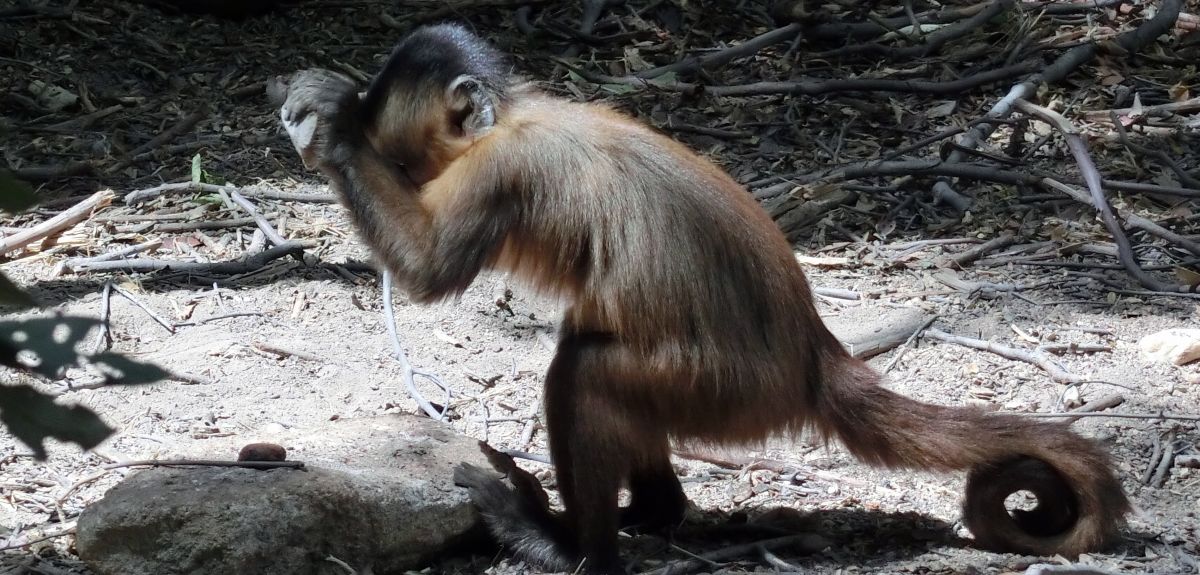
Credit: Michael Haslam/Primate Archaeology Project
Monkeys in Brazil have used stone tools for hundreds of years at least
New archaeological evidence suggests that Brazilian capuchins have been using stone tools to crack open cashew nuts for at least 700 years, and the new research paper asks whether human behaviour was influenced through watching the monkeys.
Researchers say, to date, they have found the earliest archaeological examples of monkey tool use outside of Africa. In their paper, published in Current Biology, they suggest it raises questions about the origins and spread of tool use in New World monkeys and, controversially perhaps, prompts us to look at whether early human behaviour was influenced by their observations of monkeys using stones as tools. The research was led by Dr Michael Haslam of the University of Oxford, who in previous papers presents archaeological evidence showing that wild macaques in coastal Thailand used stone tools for decades at least to open shellfish and nuts.
This latest paper involved a team from Oxford and the University of São Paulo in Brazil, who observed groups of modern capuchins at Serra da Capivara National Park in northeast Brazil, and combined this with archaeological data from the same site. Researchers watched wild capuchins use stones as hand-held hammers and anvils to pound open hard foods such as seeds and cashew nuts, with young monkeys learning from older ones how to do the same. The capuchins created what the researchers describe as 'recognisable cashew processing sites', leaving stone tools in piles at specific places like the base of cashew trees or on tree branches after use. They found that capuchins picked their favourite tools from stones lying around, selecting those most suitable for the task. Stones used as anvils were over four times heavier than hammer stones, and hammers four times heavier than average natural stones. The capuchins also chose particular materials, using smooth, hard quartzite stones as hammers, while flat sandstones became anvils.
Using archaeological methods, the researchers excavated a total of 69 stones to see if this tool technology had developed at all over time. They dug to a depth of 0.7 metres at a site close to cashew trees where they had seen modern capuchins frequently using their stone tools. They identified the tools from inspecting the size and shape of the stones, as well as the distinctive damage on the stone surface caused by capuchin pounding. Through mass spectrometry, the researchers were able to confirm that dark-coloured residues on the tools were specifically from cashew nuts. They also carbon dated small pieces of charcoal discovered with the stones to establish the oldest were least 600 to 700 years old – meaning the tools predate the arrival of Europeans in the New World.
In the paper, the researchers estimate that around 100 generations of capuchins have used this tradition of stone tools. They compared tools used by modern capuchins with the oldest excavated examples, finding they are similar in terms of weight and materials chosen. This apparent lack of change over hundreds of years suggests monkeys are ‘conservative’, preferring not to change the technology used, unlike humans living in the same region, says the paper.
Lead author Dr Michael Haslam, from the School of Archaeology at the University of Oxford, said: 'Until now, the only archaeological record of pre-modern, non-human animal tool use comes from a study of three chimpanzee sites in Cote d’Ivoire in Africa, where tools were dated to between 4,300 and 1,300 years old. Here, we have new evidence that suggests monkeys and other primates out of Africa were also using tools for hundreds, possibly thousands of years. This is an exciting, unexplored area of scientific study that may even tell us about the possible influence of monkeys’ tool use on human behaviour. For example, cashew nuts are native to this area of Brazil, and it is possible that the first humans to arrive here learned about this unknown food through watching the monkeys and their primate cashew-processing industry.'
This is an exciting, unexplored area of scientific study that may even tell us about the possible influence of monkeys’ tool use on human behaviour
Dr Michael Haslam from the School of Archaeology
Tool use by monkeys has featured in other research led by Dr Haslam in recently published papers. In a study in the Journal of Human Evolution (published in June 2016), the team noted how groups of macaques in the marine national park on Piak Nam Yai Island, Thailand, selected stones as tools to crush marine snails, nuts and crabs. They also identified 10 tools in excavations at the site, which they dated as between 10 and 50 years old. In another research paper detailing fieldwork at the same site, they say the modern macaques typically moved their tools a metre or less from where they picked them up, but the longest distance they observed was around 87m. The macaques ate nine oysters at a time, on average, and generally carried the same tool over short distances. In one case, however, the researchers saw a hungry macaque eat 63 oysters one after the other, using the same stone tool to open all the shells, says the paper.
The paper, Pre-Columbian monkey tools, is published in the latest issue of Current Biology.
 New study estimates NHS England spends 3% of its primary and secondary care budget on the health impacts of temperature
New study estimates NHS England spends 3% of its primary and secondary care budget on the health impacts of temperature
 International collaboration launches largest-ever therapeutics trial for patients hospitalised with dengue
International collaboration launches largest-ever therapeutics trial for patients hospitalised with dengue
 Oxford-built multi-agent assistant for cancer care to be piloted in collaboration with Microsoft
Oxford-built multi-agent assistant for cancer care to be piloted in collaboration with Microsoft
 World's first Phase II Nipah virus vaccine trial launch
World's first Phase II Nipah virus vaccine trial launch